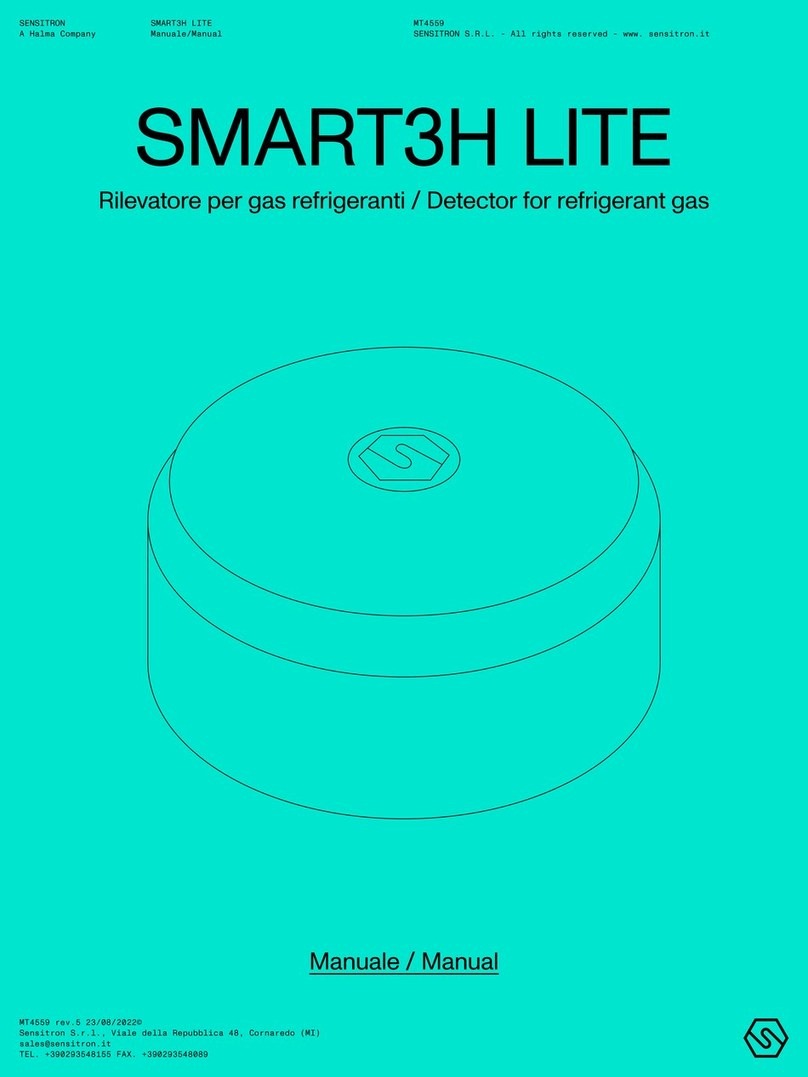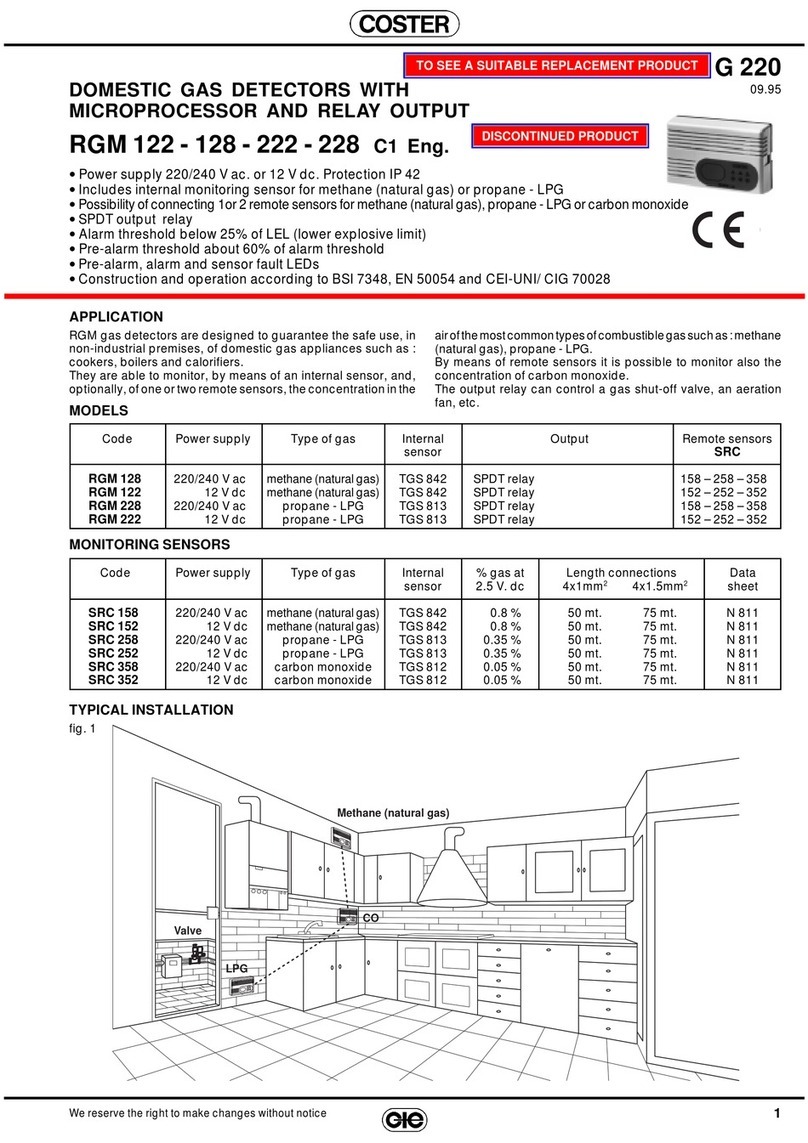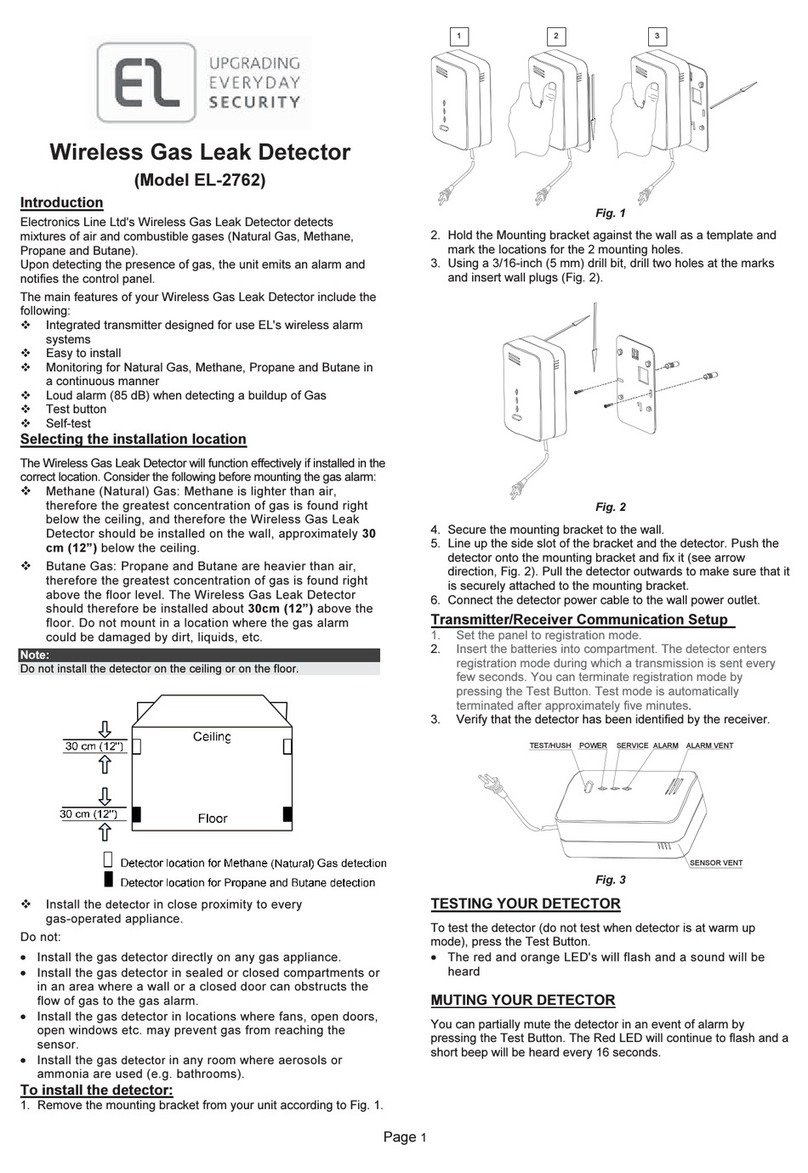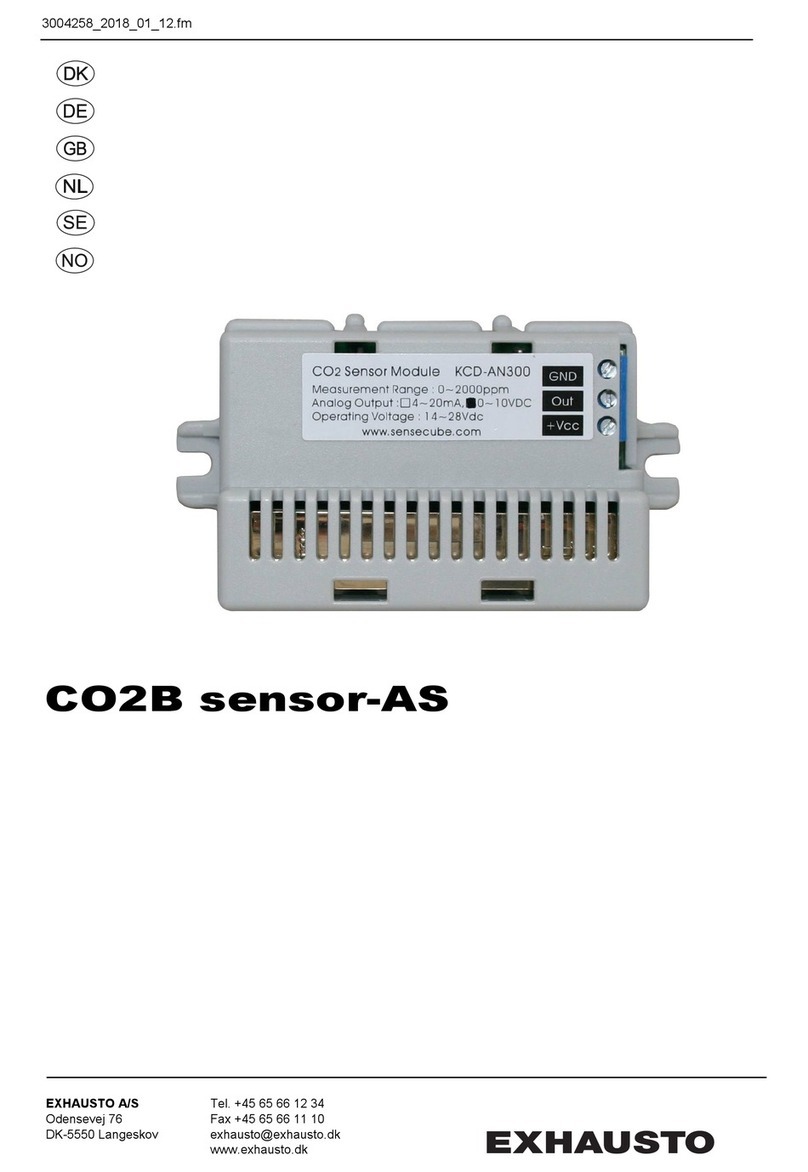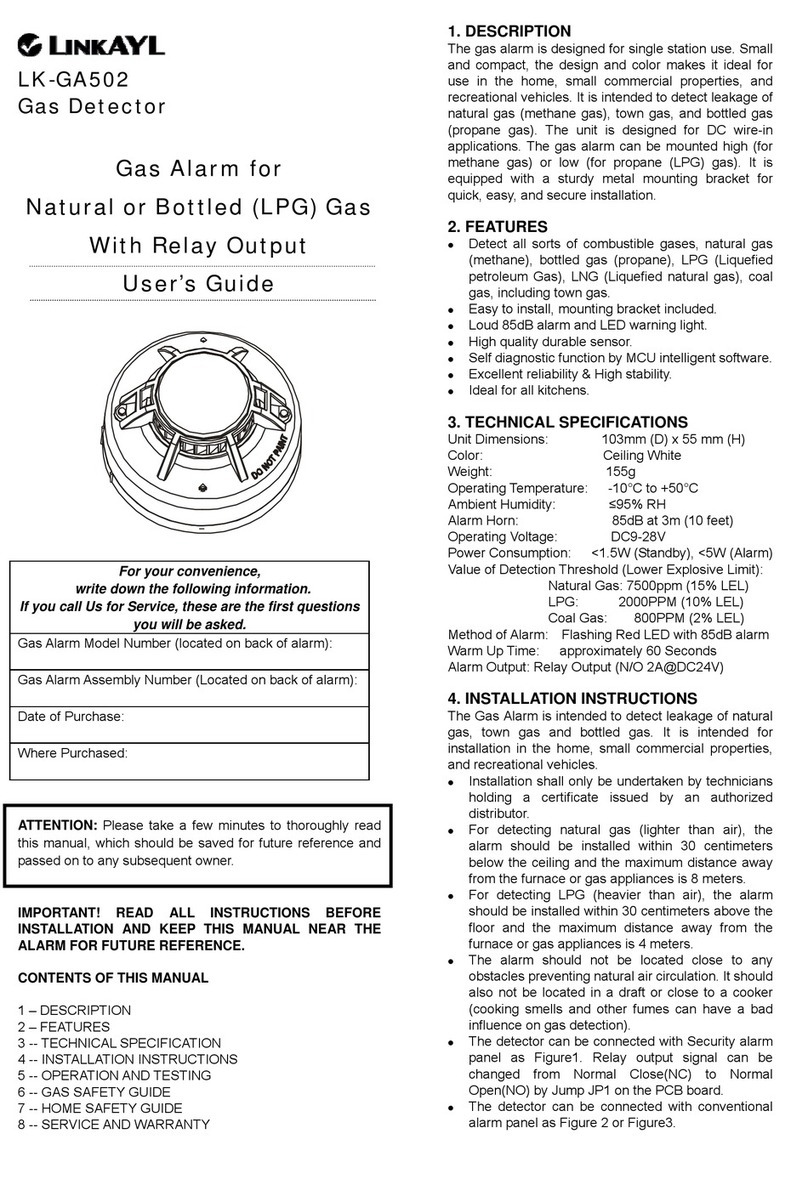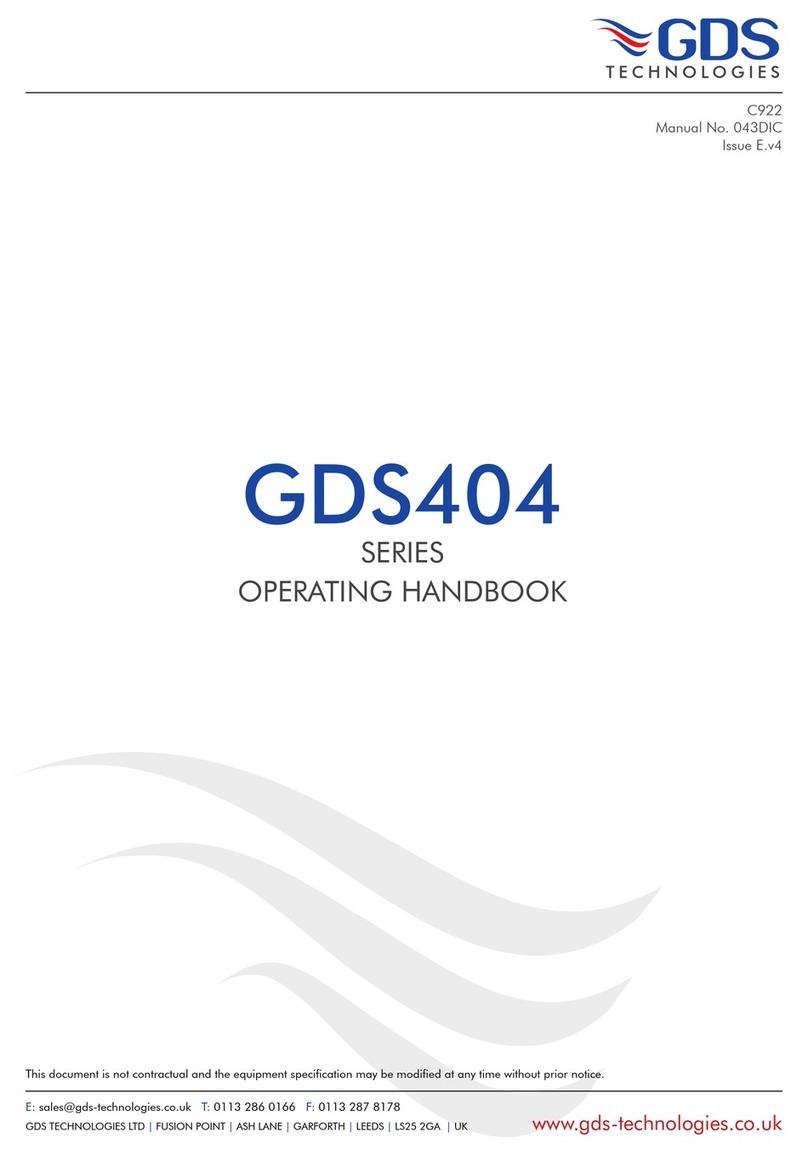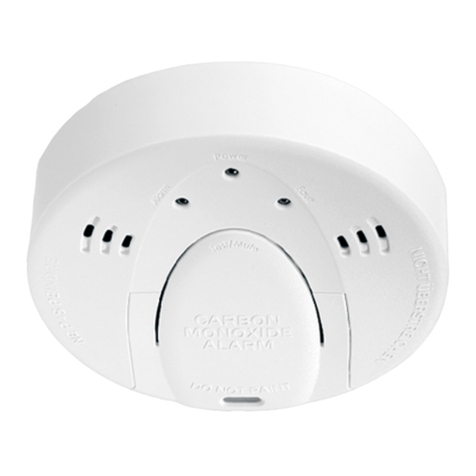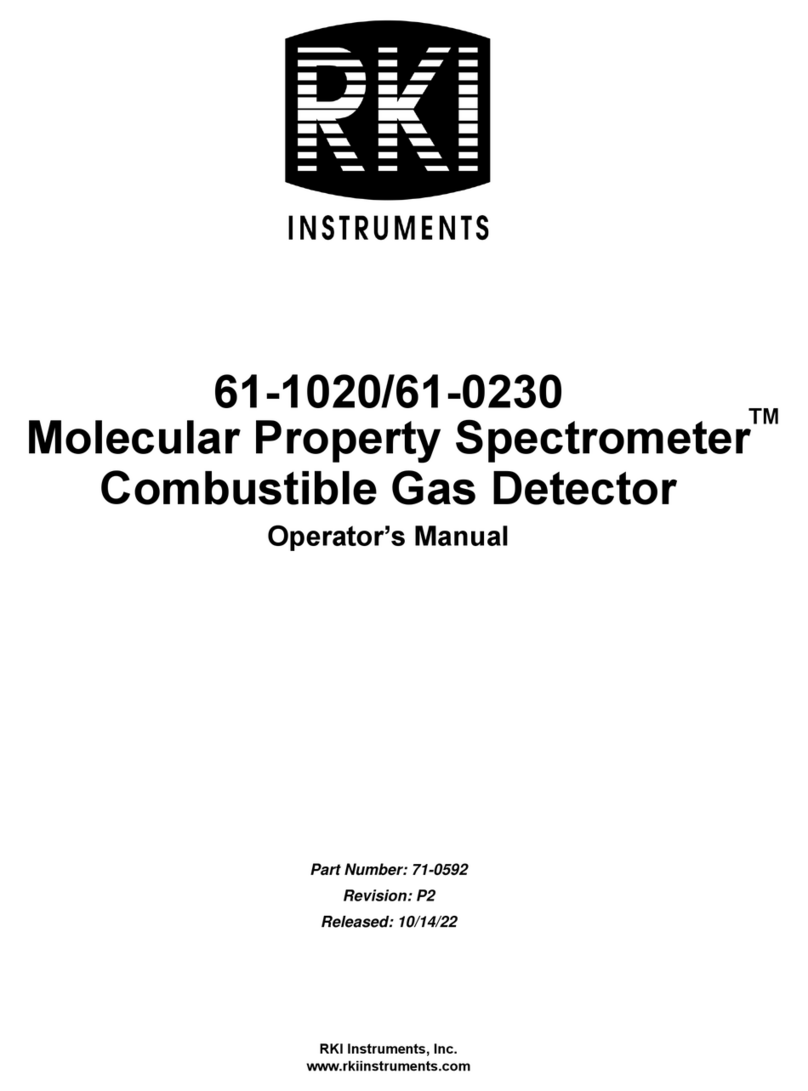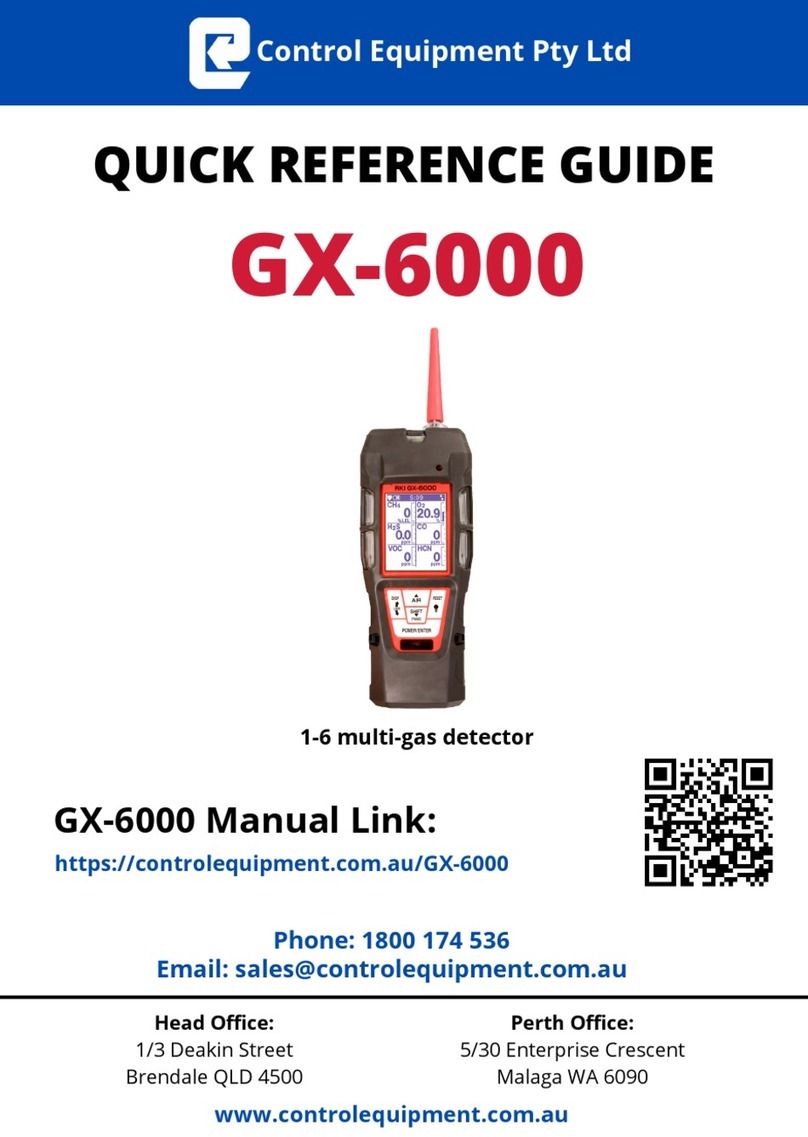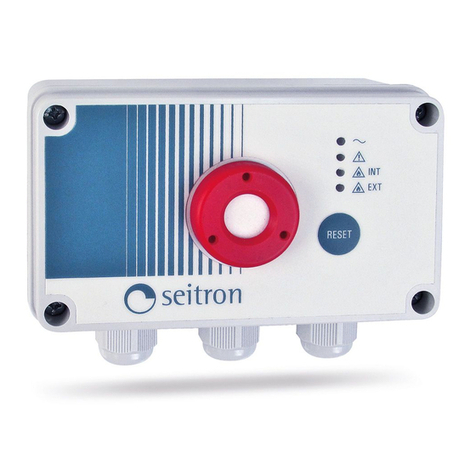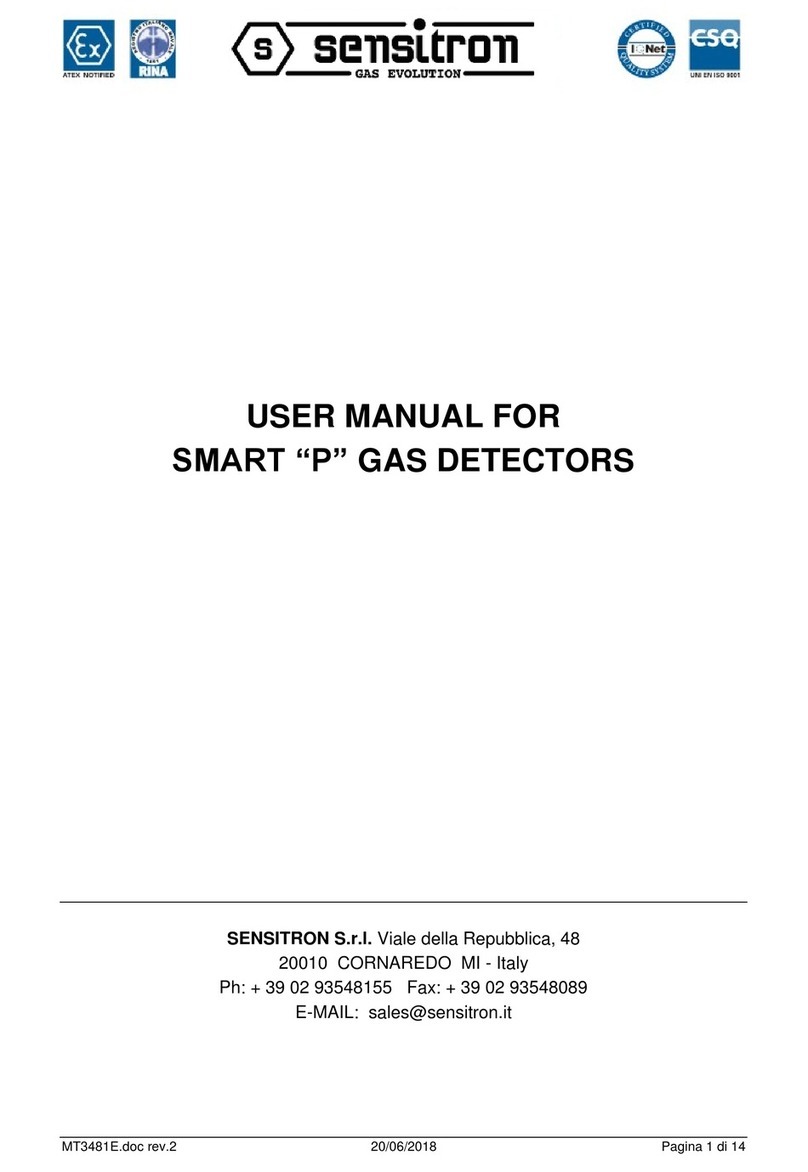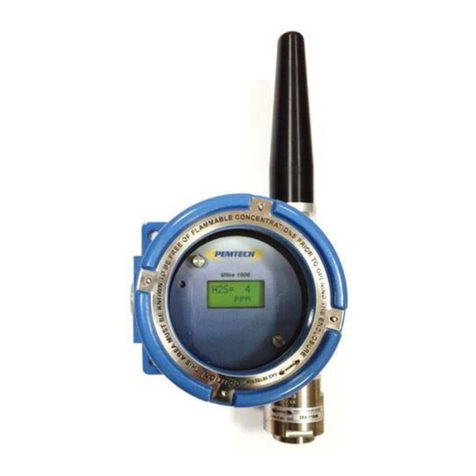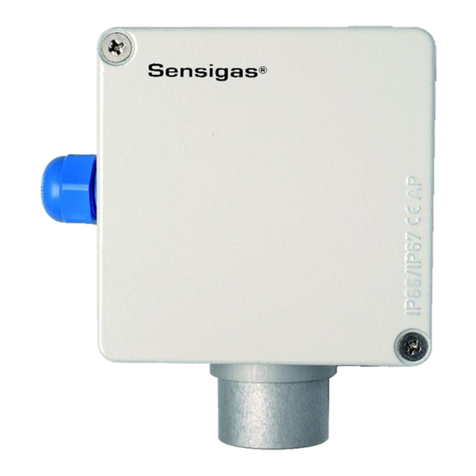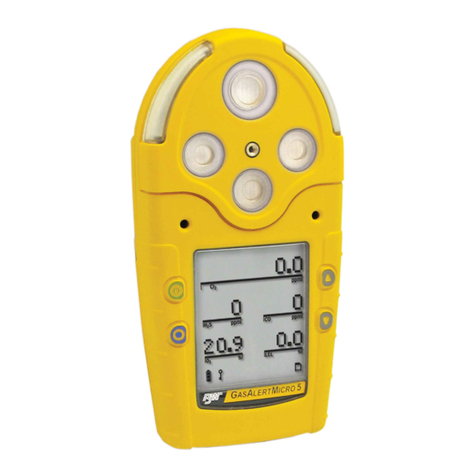GDS Corp GASMAX II + GDS-IR User manual

GDS Corp.
1245 Butler Road League City, TX 77573
409-927-2980 409-927-4180 (Fax) ww.gdscorp.com
Operation and Maintenance
Manual
GASMAX II + GDS-IR
GASMAX Gas Detector with GDS-IR Infrared Sensor
for Combustibles and Carbon Dioxide

GASMAX II + GDS-IR Operation & Maintenance Manual, Revision 1.1
Page 2
CAUTION: FOR SAFETY REASONS THIS EQUIPMENT MUST BE OPERATED AND
SERVICED BY QUALIFIED PERSONNEL ONLY. READ AND UNDERSTAND
INSTRUCTION MANUAL COMPLETELY BEFORE OPERATING OR SERVICING.
ATTENTION: POUR DES RAISONS DE SÉCURITÉ, CET ÉQUIPEMENT DOIT
ÊTRE UTILISÉ, ENTRETENU ET RÉPARÉ UNIQUEMENT PAR UN PERSONNEL
QUALIFIÉ. ÉTUDIER LE MANUE D’INSTRUCTIONS EN ENTIER AVANT
D’UTILISER, D’ENTRETENIR OU DE RÉPARER L’ÉQUIPEMENT.
REVISION HISTORY
Revision 1.0 7/24/16 Initial Release
Revision 1.1 6/29/18 Updated wiring diagrams
Copyright © 2016 GDS Corp. All Rights Reserved
P/N 1200-0949-011

GASMAX II + GDS-IR Operation & Maintenance Manual, Revision 1.1
Page 3
CONTENTS
1SAFETY INFORMATION _______________________________________________ 6
2OVERVIEW _________________________________________________________ 7
3INSTALLATION ______________________________________________________ 9
4INITIAL SETUP _____________________________________________________ 16
5CALIBRATION ______________________________________________________ 20
6MAINTENANCE_____________________________________________________ 23
7USER MENUS ______________________________________________________ 24
8TROUBLESHOOTING ________________________________________________ 34
9MODBUS INTERFACE ________________________________________________ 36
10 SPECIFICATIONS __________________________________________________ 40
11 SPARE PARTS ____________________________________________________ 41
12 DRAWINGS AND DIMENSIONS ______________________________________ 43

GASMAX II + GDS-IR Operation & Maintenance Manual, Revision 1.1
Page 4
TABLE OF FIGURES
FIGURE 3-1: GASMAX II + GDS-IR POWER & SIGNAL WIRING ...................................................................... 11
FIGURE 3-2: OPTIONAL RELAY / MODBUS INTERFACE BOARD..................................................................... 12
FIGURE 3-3: MODBUS WIRING (TYPICAL)..................................................................................................... 13
FIGURE 3-4: MODBUS WIRING (MODBUS JUNCTION BOX).......................................................................... 14
FIGURE 3-5: MODBUS JUNCTION BOX INSTALLATION OPTIONS.................................................................. 14
FIGURE 3-6: OPTIONAL ISOLATED 4-20MA OUTPUT BOARD ....................................................................... 15
FIGURE 4-1: GASMAX SINGLE CHANNEL DISPLAY ........................................................................................ 16
FIGURE 4-2: GASMAX DUAL CHANNEL DISPLAY ........................................................................................... 16
FIGURE 4-3: USER MENU SCREEN................................................................................................................. 17
FIGURE 4-4: ACCESSING CAL MODE ............................................................................................................. 17
FIGURE 4-5: GASMAX DATA DISPLAY ........................................................................................................... 18
FIGURE 4-6: GASMAX TREND DISPLAY ......................................................................................................... 18
FIGURE 5-1: CALIBRATION FLOWCHART ...................................................................................................... 20
FIGURE 5-2: LOCAL GDS-IR CALIBRATION SETUP ......................................................................................... 21
FIGURE 5-3: REMOTE GDS-IR CALIBRATION SETUP...................................................................................... 21
FIGURE 6-1: GDS-IR DISASSEMBLY & CLEANING .......................................................................................... 23
FIGURE 7-1: MAIN MENU FLOWCHART........................................................................................................ 24
FIGURE 7-2: SYSTEM CONFIG MENU ............................................................................................................ 25
FIGURE 7-3: SENSOR LIFE TRANSMISSION FORMAT .................................................................................... 26
FIGURE 7-4: ALARM SETTINGS MENU .......................................................................................................... 27
FIGURE 7-5: RS-485 MODBUS MENU ........................................................................................................... 28
FIGURE 7-6: SENSOR SETTINGS MENU ........................................................................................................ 28
FIGURE 7-7: CLOCK DELAY MENU................................................................................................................. 29
FIGURE 7-8: CONTRAST MENU ..................................................................................................................... 29
FIGURE 7-9: DIAGNOSTICS MENU ................................................................................................................ 30
FIGURE 7-10: SYSTEM SECURITY MENU ....................................................................................................... 30
FIGURE 7-11: XMITTER CONFIG MENU ........................................................................................................ 31
FIGURE 7-12: TECHNICAL PAGE MENU......................................................................................................... 32
FIGURE 7-13: SENSOR BALANCE & VOLTAGE SET MENU ............................................................................. 33
FIGURE 7-14: SET GAIN TO UNITY MENU ..................................................................................................... 33
FIGURE 11-1: GASMAX II + GDS-IR SPARE PARTS ......................................................................................... 41
FIGURE 11-2: GASMAX EXPANSION BOARDS ............................................................................................... 41
FIGURE 11-3: GDS-IR REMOTE SENSOR SPARE PARTS.................................................................................. 42
FIGURE 12-1: GASMAX II + GDS-IR DIMENSIONS (LOCAL VERTICAL SENSOR).............................................. 43

GASMAX II + GDS-IR Operation & Maintenance Manual, Revision 1.1
Page 5
FIGURE 12-2: GASMAX II + GDS-IR DIMENSIONS (LOCAL HORIZONTAL SENSOR) ........................................ 44
FIGURE 12-3: GDS-IR DIMENSIONS (REMOTE VERTICAL SENSOR) ............................................................... 45
FIGURE 12-4: GDS-IR DIMENSIONS (REMOTE VERTICAL SENSOR WITH DUCT MOUNT) ............................. 46
FIGURE 12-5: GDS-IR DUCT MOUNT HOLE CUTOUT PATTERN..................................................................... 47
FIGURE 12-6: GDS-IR RAIN SHIELD P/N 20-0236 (HORIZONTAL MOUNT).................................................... 48
FIGURE 12-7: GDS-IR RAIN GUARD P/N 3000-9005 (VERTICAL MOUNT ..................................... 48
FIGURE 12-8: WIRING DIAGRAM - LOCAL GDS-IR SENSOR........................................................................... 49
FIGURE 12-9: WIRING DIAGRAM - REMOTE GDS-IR SENSOR (3-WIRE INTERFACE) ..................................... 50
FIGURE 12-10: WIRING DIAGRAM - REMOTE GDS-IR SENSOR (4-WIRE INTERFACE) ................................... 51
FIGURE 12-11: WIRING DIAGRAM - LOCAL GDS-IR USING P/N 20-0235 INTERFACE PCB ............................ 52
FIGURE 12-12: WIRING DIAGRAM - REMOTE GDS-IR USING P/N 20-0235 INTERFACE PCB......................... 53
FIGURE 12-13: WIRING DIAGRAM - DUAL REMOTE GDS-IR ......................................................................... 54

GASMAX II + GDS-IR Operation & Maintenance Manual, Revision 1.1
Page 6
1SAFETY INFORMATION
Important Read Before Installation
Users should have a detailed understanding of GASMAX II operating and maintenance instructions. Use
the GASMAX II only as specified in this manual or detection of gases and the resulting protection provided
may be impaired. Read the following WARNINGS prior to use.
WARNINGS
•CAUTION: KEEP EXPLOSION PROOF COVER TIGHT WHILE CIRCUITS ARE ALIVE
•MISE EN GARDE : GARDER EXPLOSION COUVERTURE PREUVE TIGHT CIRCUITS PENDANT QUE SONT
ALIVE
•Unit must be installed, operated and maintained in accordance with information contained herein.
Installation in any hazardous area must comply with all applicable restrictions, requirements and
s final decision to ensure that the
GASMAX II is suitable for the intended use.
•The GASMAX II + GDS-IR gas monitor is designed and constructed to measure the level of certain
gases in ambient air. Accuracy in atmospheres containing steam or inert gases cannot be guaranteed.
•The GDS-IR may be mounted vertically or horizontally. Do not mount the GDS-IR upside down.
•Do not paint transmitter or sensor assembly.
•Do not operate the GASMAX II + GDS-IR if its enclosure is damaged or cracked or has missing
components.
applying power.
•Do not expose the GASMAX II + GDS-IR to electrical shock or continuous severe mechanical shock.
Protect the GASMAX II + GDS-IR from dripping liquids and high power sprays.
•Calibrate with known target gas at start-up and check on a regular schedule, at least every 90 days.
More frequent inspections are encouraged to spot problems such as dirt, oil, paint, grease or other
foreign materials on the sensor head.
•
targeted gas concentration above the High Alarm set point.
•Use only for applications described within this manual.

GASMAX II + GDS-IR Operation & Maintenance Manual, Revision 1.1
Page 7
MEASUREMENT NAME
12
% LEL
2OVERVIEW
The GASMAX II + GDS-IR gas monitor integrates the GASMAX II gas monitor
with the GDS-IR standalone infrared gas sensor. The combination provides an
ideal solution with local or remote display, built-in calibration, convenient IR
Zero options and diagnostics with Fault display.
GASMAX II GAS MONITOR
The GASMAX II is a single or dual channel fixed-point gas monitor designed to
provide continuous monitoring of toxic or combustible gases in hazardous
areas. Gas values are displayed in calibrated engineering units as well as bar
graph or 30-minute trend graph format.
The GASMAX II supports one local or one local and one remote GDS-IR
infrared sensor. The advanced microcontroller, non-intrusive magnetic
interface and superior graphic LCD interface offers rapid setup, simplified
operation and enhanced diagnostics not found in previous generation
products. On-board non-volatile memory retains all configuration data during
power interruptions. Two independent 4-20 mA outputs allow for easy
connection to control systems or other alarm instrumentation. Additional
output options include alarm relays and single channel MODBUS slave
interface.
Built-in user-prompted calibration makes it easy for one person to perform
calibration and maintenance without opening the enclosure or declassifying
the area. A battery-powered real-time clock and event log allows the
GASMAX II to track calibration and alarm events for later recall on the LCD
readout.
Key Features:
•CSA Certified for Class I Div 1 hazardous locations
•Graphic display shows values, units, trends and alarm levels
•Supports both local and remote sensors
•Non-intrusive, prompted calibration procedure
•Power-up POST delays eliminate false alarms
•Backlit display for better visibility in low light conditions
•Options include MODBUS, isolated 4-20mA
•Security settings to lock critical parameters
•Two year warranty
GASMAX II with Local
GDS-IR Infrared Sensor

GASMAX II + GDS-IR Operation & Maintenance Manual, Revision 1.1
Page 8
GDS-IR INFRARED SENSOR FOR COMBUSTIBLES AND CO2
The GDS-IR is ideally suited for use in harsh environments and where the
cost of required maintenance for conventional catalytic detectors is
prohibitive. The GDS-IR Infrared gas detector will perform reliably in the
presence of silicone and other catalytic poisoning agents and can also
operate in oxygen free environments or where high background gas levels
are present. There are no known poisons that affect this technology.
Key Features:
•Certified for use in Class I Division 1, Groups B, C & D hazardous areas
•CSA performance certified (C22.2 No. 152)
•Approved for use in SIL-2 safety systems
•Standard 4 to 20 mA output (current source)
•Requires no routine span calibration.
•Continuous self-test automatically indicates a fault
•Multi-layered filtering system protects optics from dirt and water
ingress
•Straight optical path eliminates the need for mirrors or reflective
surfaces
•Performs well in the presence of high concentrations or constant
background levels of hydrocarbons
•Does not require oxygen to detect hydrocarbons
•Constructed of 316 stainless steel
•Five year warranty
GASMAX II with Remote
GDS-IR Infrared Sensor
MEASUREMENT NAME
12
% LEL

GASMAX II + GDS-IR Operation & Maintenance Manual, Revision 1.1
Page 9
MEASUREMENT NAME
12
%
3INSTALLATION
SELECTING A LOCATION
Factors such as prevailing winds, gas density, potential leak sources, air movement machinery and similar
environmental variables are important when selecting a location for any gas monitor. Even though the
GASMAX II is designed for rugged service, sensors and electronics should be protected from damage due
to environmental effects including liquid water, snow, shock, vibration and dirt.
In addition, the GASMAX display should be located such that regular maintenance and periodic sensor
replacement can be readily accomplished. While there are no industry standards for gas detector
placement, professional tools exist that can simulate leaks or spills and provide excellent guidance for
locating gas detectors throughout a facility.
MOUNTING THE GASMAX II + GDS-IR Sensor (Vertical Orientation)
Mount the GASMAX II + GDS-
mounting ears located on each side of the yellow enclosure. See Drawings and
Dimensions for detailed measurements. While the GASMAX II + GDS-IR can be
mounted flush against a wall, GDS Corp recommends that the GDS-IR sensor be
located in such a way as to allow air to flow past the sensor from any direction. In
addition, space around the GDS-IR will allow a Rain Guard (p/n 3000-9005) to be
installed if necessary.
The type of gas to be detected will determine the recommended height above
ground. To detect heavy gases, such as propane or ethylene, mount the sensor
in indoor situations, mount the
sensor at eye level or near the ceiling.
To make calibration easier, GDS Corp recommends the remote sensor configuration for heavy gases. This
allows the display to be located at eye level while the sensor is located near the floor.
IMPORTANT: BELOW THE GDS-IR SENSOR TO FACILITATE THE
REMOVAL AND REPLACEMENT OF THE GDS-IR SENSOR COVER AND HYDROPHOBIC FILTER AND TO ALLOW
ACCESS TO THE CALIBRATION GAS INLET NIPPLE ON THE BOTTOM OF THE SENSOR.
MOUNTING THE GASMAX II + GDS-IR Sensor
(Horizontal Orientation)
The GASMAX II + GDS-IR can also be ordered with
the sensor mounted horizontally (sensor head type
sensor is limited or if a Rain Shield (p/n 20-0236) is to
be installed on the GDS-IR.
Fittings are both and wiring can enter the
sensor head from either the left or right side.
MEASUREMENT NAME
12
%

GASMAX II + GDS-IR Operation & Maintenance Manual, Revision 1.1
Page 10
IMPORTANT: TO THE RIGHT OF THE GDS-IR SENSOR TO FACILITATE
THE REMOVAL AND REPLACEMENT OF THE GDS-IR SENSOR COVER, HYDROPHOBIC FILTER AND RAIN
SHIELD AND TO ALLOW ACCESS TO THE CALIBRATION GAS INLET NIPPLE ON THE BOTTOM OF THE
SENSOR.
MOUNTING THE GASMAX II + GDS-IR (Remote Sensor
Configuration))
Using a remote configuration allows the GDS-IR sensor to be mounted in
the best possible location to detect gas, while at the same time allowing
the GASMAX display to be installed at eye level for easy setup and
calibration.
Whenever possible, GDS Corp recommends a four-wire interface between
the GASMAX display and GDS-IR sensor. The presenc
-IR hardware zero command to be
triggered from either the GASMAX display or the local GDS-IR junction box.
If there are only three wires available between the GASMAX display and
the GDS-IR, then the combination will work but the GDS-IR hardware zero
will have to be done locally at the GDS-IR junction box. See the chapter on
Drawings and Dimensions for details of the remote wiring options.
HAZARDOUS AREA INSTALLATION
GASMAX II monitors and GDS-IR Infrared Sensors are certified for use in
Class 1 Division 1 hazardous areas. Installation in these areas should follow
required industry standard practices and all appropriate electrical codes. Generally, these codes require
rigid metal conduit, poured seals and other installation elements necessary to ensure safety.
For maximum protection against RF interference or electrical surge, the GASMAX II enclosure, all remote
sensors and interconnecting conduit must be properly grounded.
CAUTION: KEEP EXPLOSION PROOF COVER TIGHT WHILE CIRCUITS ARE ALIVE
MISE EN GARDE : GARDER EXPLOSION COUVERTURE PREUVE TIGHT CIRCUITS PENDANT QUE
SONT ALIVE
INTRINSICALLY SAFE INSTALLATION
The GASMAX II + GDS-IR is not certified for use as an Intrinsically Safe device.
MEASUREMENT NAME
12
% LEL
4

GASMAX II + GDS-IR Operation & Maintenance Manual, Revision 1.1
Page 11
CONNECTING DC POWER & OUTPUT SIGNAL WIRING
To access the GASMAX signal and power connections, remove the cover on the GASMAX II explosion-
proof enclosure, loosen the 2 thumbscrews holding the display assembly and remove it. The display will
remain connected to the IO/Power Supply PCB mounted in the back of the enclosure by a short ribbon
cable. Route the power and signal wires through the conduit entry and connect to TB2
Plus 24VDC connects to TB2-1. DC Ground connects to TB2-4. Channel One 4-20mA output is available on
TB2-2 and Channel Two 4-20mA output is available on TB2-3.
GDS Corp always recommends using shielded wire for signal and power cable.
Figure 3-1: GASMAX II + GDS-IR Power & Signal Wiring
TB2 1: +12-30VDC Input
TB2 2: Channel 1 (4-20mA Out)
TB2 3: Channel 2 (4-20mA Out)
TB2 4: Power / Signal Common
NOTE: The maximum distance 4-20 mA signals can
travel is dependent upon cable gauge, DC power
supply voltage level and input impedance of the
receiving device. Assuming a nominal 24 VDC
power supply, the maximum total loop resistance
is approximately 750 ohms.
Examples:
#18GA, 0.0064 ohm/ft => 11 miles
#24GA, 0.026 ohms/ft => 2.7 miles

GASMAX II + GDS-IR Operation & Maintenance Manual, Revision 1.1
Page 12
OPTIONAL RELAY + MODBUS INTERFACE
The optional 10-0234 Relay / Modbus board is to the back of the GASMAX II
Display Assembly and supplies two level alarm relays , a FAULT relay and an RS-485
Modbus RTU slave port. If dual isolated 4-20mA outputs are not installed, GASMAX II units may be field
upgraded with this option at any time.
RELAY FUNCTIONALITY
Alarm relays eld
Power must be supplied from an external source and should be fused.
WARNING: CONTACTS ARE RATED FOR RESISTIVE LOADS ONLY! INDUCTIVE LOADS, SUCH AS COILS,
MOTORS OR SOLENOID VALVES MAY CAUSE ARCING WHICH SHORTENS LIFE AND MAY INTERFERE WITH
SENSOR DATA. IF OPERATING AN INDUCTIVE LOAD, BE SURE TO INSTALL A PROTECTIVE DIODE OR
AT THE LOAD PINS TO MINIMIZE REVERSE EMF ARCING.
Relay K1 activates if either Channel 1 or Channel 2 exceed the programmed alarm 1 threshold and cannot
be acknowledged. Relay K2 activates if either Channel 1 or Channel 2 exceed the programmed alarm 2
threshold and can be acknowledged (reset) from the front panel or via TB3. Relay K3 indicates sensor
failure and is always failsafe (normally open held closed).
Remote Alarm Reset (TB3) can be used to acknowledge an Alarm 2 relay contact closure via a remote
pushbutton. Use a momentary dry-contact normally--
Wiring from any remote pushbutton to TB3 should be shielded and protected from noise spikes to
prevent false Alarm Reset commands.
A version of this board is available with MODBUS RTU slave only configuration (No relays).
Figure 3-2: Optional Relay / MODBUS Interface Board
MODBUS WIRING
Typical MODBUS wiring is shown in Figure 4-6. MODBUS system architecture requires that the devices in
any MODBUS loop be connected in a daisy-chain layout. This minimizes signal reflections and improves
-
-

GASMAX II + GDS-IR Operation & Maintenance Manual, Revision 1.1
Page 13
signal noise margin. A MODBUS Termination Jumper installs a load resistor across the MODBUS signal
lines and should only AON) at the last device in the string.
Cable selection for MODBUS systems is important for both signal integrity and power distribution.
MODBUS / RS-485 transmissions use low-voltage differential signaling to achieve reasonable data rates
over very long distances, up to 4000 feet without a repeater. For MODBUS data signals, GDS Corp
recommends 24GA shielded cable for best results. Power distribution, however may require larger gauge
wire since it is critical that the supply voltage for the GASMAX at the far end of the string not fall below
18VDC during power-up and normal operation.
Figure 3-3: MODBUS Wiring (Typical)
-
I/O Power Supply board. This can be difficult if wire sizes are larger than #18ga. Further, the addition of
multiple MODBUS and power wires inside the GASMAX enclosure can create problems and possibly
damage components if the display has to be forced into place. Finally, if it is desired to disconnect the
GASMAX from the MODBUS loop for troubleshooting, disconnecting the power wire removes power from
all devices further down the loop and leaves a live male pin with +24V inside the enclosure.
For these reasons, GDS Corp recommends the addition of the MODBUS Wiring Junction Box. This option
minimizes the need to access wiring inside the GASMAX II, provides individual wire landing points for
incoming and outgoing MODBUS and power wiring and shields, and makes it easy to temporarily
-

GASMAX II + GDS-IR Operation & Maintenance Manual, Revision 1.1
Page 14
disconnect the GASMAX II power or MODBUS connections without affecting any other MODBUS devices.
Figure 3-4: MODBUS Wiring (MODBUS Junction Box)
The MODBUS wiring junction box is attached to the GASMAX, either on the bottom fitting or one of the
side fittings, depending on installation requirements. Specify BOTTOM, LSIDE or RSIDE when ordering (See
Fig. 4-8).
Figure 3-5: MODBUS Junction Box Installation Options
--

GASMAX II + GDS-IR Operation & Maintenance Manual, Revision 1.1
Page 15
OPTIONAL ISOLATED 4-20MA OUTPUT BOARD
The optional 10-0250 Isolated 4-20mA output board provides two 4-20mA outputs that are electrically
isolated from sensor inputs and the 24 VDC power source. Each 4-20mA output shares the same common
ground and are therefore not isolated from each other. This board is to the back
of the GASMAX II Display Assembly. GASMAX II units may be field upgraded with this option at any time.
NOTE: THE ISOLATED 4-20MA AND MODBUS / RELAY BOARDS SHARE THE SAME CONNECTOR AND
THEREFORE CANNOT BE INSTALLED AT THE SAME TIME.
Figure 3-6: Optional Isolated 4-20mA Output Board
-
-
-
-
-
-

GASMAX II + GDS-IR Operation & Maintenance Manual, Revision 1.1
Page 16
4INITIAL SETUP
When power is applied to the GASMAX II, the screen will -IR sensors may initially
indicate off-scale high or low values, but should quickly return to zero within a few minutes if no target
gas is present. During this warm-up delay period, the 4-20mA output is held at 4.0 mA to eliminate false
alarms in any receiving devices.
GASMAX USER INTERFACE
The GASMAX II display is shown below. There are four magnetic switches on the face of the GASMAX II,
arranged in a quadrant around the LCD display; these are labeled NEXT, EDIT, DOWN/CAL and UP. To
For the balance of this
Figure 4-1: Gasmax Single Channel Display
Pressing the NEXT key causes the GASMAX display to switch display screens. In single channel mode, the
display will switch between DATA and TREND. In dual channel systems, the sequence will be: DATA 1,
DATA 2, TREND 1, TREND 2, DUAL CHANNEL, followed by DATA 1.
Figure 4-2: Gasmax Dual Channel Display
MEASUREMENT NAME
12
% LEL
12 % LEL

GASMAX II + GDS-IR Operation & Maintenance Manual, Revision 1.1
Page 17
Press the EDIT key to access the USER MENU display mode. When in user menu display mode, use UP
and DOWN to select an item, EDIT to change an item, and NEXT to exit the menu or function and return
the GASMAX II to display mode. See Chapter 8 for more information on User Menus.
Figure 4-3: User Menu Screen
NOTE: TAKE CARE WHEN CHANGING GASMAX MENU SETTINGS INCORRECT SETTINGS COULD CAUSE
THE GASMAX TO BECOME INOPERATIVE AND MAY COMPROMISE THE SAFETY OF THE GAS DETECTION
SYSTEM. BE SURE TO UNDERSTAND WHAT TO CHANGE AND WHY BEFORE ENTERING THE USER MENU.
Press the DN/CAL key, followed by the EDIT key, to access CALIBRATION MODE. Regular calibration is
critically important to the continued safe operation of any gas detection system. See Chapter 6 for more
information on calibration.
Figure 4-4: Accessing Cal Mode
NOTE: TAKE CARE WHEN APPLYING CALIBRATION GAS TO THE GASMAX WHILE NOT IN CALIBRATION
MODE. THIS WILL CAUSE AN INCREASE IN THE 4-20MA OUTPUT SIGNAL AND MAY RESULT IN
UNINTENDED AND UNEXPECTED ALARM CONDITIONS.
MORE INFORMATION ON DISPLAY SCREENS
formation. The current value is shown in calibrated
engineering units. A horizontal bargraph tracks the current value and shows the Alarm 1 and Alarm 2
values in graphical form. The user-
text strings are shown below the real-time reading.
To access Cal
Mode, press the
DN/CAL key first
Then press the EDIT
key to confirm
Calibration Mode

GASMAX II + GDS-IR Operation & Maintenance Manual, Revision 1.1
Page 18
Above the LCD display, three LEDs indicate the status of the level and fault alarms. If relays are installed,
the LEDs indicate whether the relays are active. Note that if any relay is set for FAILSAFE operation, if LED
is ON the relay will be de-energized. In dual channel mode, if either channel is in alarm the corresponding
A1 or A2 indicator LED (and relay) will be energized.
Figure 4-5: GASMAX Data Display
Two LEDs monitor the MODBUS RS-485 transmit (TXD) and receive (RXD) buffers. Flashing indicates sent
or received data. RXD will flash whenever a message from the MODBUS master is received and TXD will
flash when any response message is transmitted from the GASMAX.
Figure 4-6: GASMAX Trend Display
The TREND screen displays a graph with the last 30 minutes of live readings. The EUNITS value is shown at
the top and Alarm 1 and Alarm 2 levels are shown as dotted (A1) and dashed (A2) lines.
PROGRAMMING ALARM SETTINGS
GASMAX II gas monitors have front panel LED indicators for ALARM 1, ALARM 2 and ALARM 3 / FAULT as
well as optional alarm relays. Alarm processing will trigger an alarm condition when the input exceeds the
programmed value, and includes hysteresis to keep the alarm from rapidly switching ON and OFF if the
input remains close to the programmed alarm value.
NOTE: ALARM RELAYS ARE NORMALLY TRIGGERED IF EITHER CHANNEL 1 OR CHANNEL 2 ALARM
THRESHOLDS ARE EXCEEDED.
NOTE: IF THE OPTIONAL ALARM RELAYS ARE NOT INSTALLED, ALARM 1 AND 2 SETTINGS AFFECT THE
OPERATION OF THE FRONT PANEL LEDS ONLY. SEPARATE ALARM SETTINGS MAY NEED TO BE
PROGRAMMED IN THE 4-20MA RECEIVING DEVICE.
MEASUREMENT NAME
12
% LEL
12 % LEL
Engineering Units Value
Horizontal Bargraph
Alarm Levels
Alarm Indication LEDs
MODBUS Communications LEDs
Engineering Units
30 Minute Trend
Alarm 2 Level (Dashed)
Alarm 1 Level (Dotted)

GASMAX II + GDS-IR Operation & Maintenance Manual, Revision 1.1
Page 19
ALARM 1, ALARM 2
Alarm 1 and Alarm 2 are identical functions that will trigger front panel LED indicators and (if installed)
optional alarm relays. Both can be set to activate whenever the input signal goes above or below a given
engineering units set point, and individual values for ON Delay and OFF Delay can be programmed to
reduce spurious trips and maintain an alarm relay in the ON state for up to 5 minutes after an alarm
clears. Relays can also be set for Normal or Failsafe. When in the Failsafe configuration, the relay is
energized in the normal state and becomes de-energized if an alarm condition occurs. Alarms can be set
to Latch (remain ON once triggered until acknowledged) or automatically clear once the alarm condition
no longer exists.
ALARM 3 –FAULT ALARM
Alarm 3 is typically used to detect a FAULT condition and is normally set for -10% of scale. The GDS-IR
sensor includes a number of diagnostic level outputs between 0mA and 4mA that will trigger the FAULT
condition. Once FAULT is recognized, the output of the GASMAX goes to 0mA and the optional FAULT
relay is triggered.
ALARM 3 –USE AS 3rd ALARM
ALARM 3 is typically used to indicate FAULT conditions that suggest sensor failure
LARM 3
menu is identical to ALARM 1 and ALARM 2 and may be set to trip at any level.
NOTE: ALARM 3 WILL ALSO TRIP WITH MISSING OR FAILED SENSORS REGARDLESS OF THE PROGRAMMED
LEVEL VALUE.
FINAL TRANSMITTER SETUP
Once operational, the user should verify the following transmitter settings prior to initial calibration.
Setting these values during warm-up is recommended.
1. Local time and date: Check date value and adjust time for proper time zone.
2. Tag name or Engineering Units settings: Edit values as necessary.
3. CAL SPAN GAS value: Set to match concentration of calibration gas cylinder.
4. CAL MARKER value: Adjust desired output mA during calibration.
5. ALARM 1, ALARM 2 settings: Set for desired levels. NOTE: If relays are not installed, GASMAX II
programmable alarm levels affect operation of front panel LEDs only.
A NOTE ON WARM UP
Allow the GASMAX II to stabilize for at least four hours, preferably overnight if possible. This will allow the
GDS-IR to reach stable equilibrium with respect to environmental conditions such as ambient
temperature, humidity, and barometric pressure.
Once warm-up is complete, the GASMAX II can be calibrated and made operational.

GASMAX II + GDS-IR Operation & Maintenance Manual, Revision 1.1
Page 20
5CALIBRATION
CALIBRATION OVERVIEW
Calibration is critically important to ensure correct operation of the GASMAX II. The built-in CAL MODE
function is designed to make calibration quick, easy and error free; a successful ZERO and SPAN
calibration requires only four keystrokes.
During CAL MODE the sensor output is disabled and the GASMAX II transmits a fixed mA value, called the
CAL MARKER, to notify the receiving device that a calibration is in progress. During the following CAL
PURGE DELAY time, the GASMAX II transmits a fixed 4.0 mA signal to prevent external alarms during
calibration. In the case of local or remote Oxygen sensors, during CAL PURGE DELAY the output simulates
a typical atmospheric reading of 20.8%. CAL MODE automatically exits if no keystrokes are detected after
5 minutes.
Follow these GASMAX II calibration guidelines:
•Calibration accuracy is only as good as the calibration gas accuracy. GDS Corp calibration gases are
traceable to NIST (National Institute of Standards and Technology).
•Never use calibration gas that has passed its expiration date.
•Check the SPAN GAS VALUE setting and make sure it matches the calibration gas. (See Fig. 6-2)
•Always use a GDS Corp calibration cup that completely surrounds the sensor head.
•Be sure to use ZERO AIR, a mixture of 21% oxygen and 79% nitrogen, as a zero reference unless you
condition that will cause a FAULT to occur once the ambient gas is no longer present.
•Always calibrate a new sensor before depending on the device for personnel or equipment safety
•Calibrate on a regular schedule. GDS Corp recommends a full calibration every 3 months, with
on a more frequent basis to ensure that the sensor has not been affected by
temperature extremes or the presence of incompatible gases.
Figure 5-1: Calibration Flowchart
Table of contents

